Role of Thymus ciliatus (Thyme) to Ameliorate the Acute Neurotoxicity Induced by Bisphenol A: In Vivo Supported with Virtual Study
Abstract
:1. Introduction
2. Results
2.1. Yield and Principal Components of Essential Oil (TEO)
2.2. Neurobehavioral Tests
2.2.1. Dark/Light Test
2.2.2. Y-Maze Test
2.2.3. Forced Swimming Test
2.2.4. Test for Sucrose Tolerance
2.2.5. Morris Pool Test
Learning Phase
Probe Test
2.2.6. Open Field Test
2.3. Biochemical Assay
Glucose Levels in the Blood
2.4. Effect of TEO on the Brain Histology of Rats Treated with BPA
2.5. In Silico Docking Study
2.5.1. Interaction with Human 5HT2C Receptor (PDB ID: 8DPH)
2.5.2. Interactions with Monoamine Oxidase (MAO) Enzyme (PDB ID: 8EEJ)
2.5.3. Interactions with Human Acetylcholinesterase Enzyme (PDB ID: 4EY5)
2.5.4. Interactions with Human Butyrylcholinesterase Enzyme (PDB ID: 6I0C)
3. Discussion
4. Materials and Methods
4.1. Thymus ciliatus Extraction and Identification by GC-MS
4.2. Animal Treatment and Dividing Groups
4.3. Neurobehavioral Tests
4.3.1. Dark/Light Test
4.3.2. Y-Maze Test
4.3.3. Test of Forced Swimming
4.3.4. Test for Sucrose Tolerance
4.3.5. The Morris Pool
4.3.6. Open Field Test
4.4. Biochemical Assays
Blood Glucose Levels
4.5. A Study of Brain Histology
4.6. In Silico Docking Study
4.7. Statistical Analysis
5. Conclusions
Supplementary Materials
Author Contributions
Funding
Institutional Review Board Statement
Informed Consent Statement
Data Availability Statement
Acknowledgments
Conflicts of Interest
References
- Silva, B.S.; Bertasso, I.M.; Pietrobon, C.B.; Lopes, B.P.; Santos, T.R.; Peixoto-Silva, N.; Carvalho, J.C.; Claudio-Neto, S.; Manhães, A.C.; Cabral, S.S.; et al. Effects of maternal bisphenol A on behavior, sex steroid and thyroid hormones levels in the adult rat offspring. Life Sci. 2019, 218, 253–264. [Google Scholar] [CrossRef] [PubMed]
- Park, S.K.; Tao, Y.; Meeker, J.D.; Harlow, S.D.; Mukherjee, B. Environmental risk score as a new tool to examine multi-pollutants in epidemiologic research: An example from the NHANES study using serum lipid levels. PLoS ONE 2014, 9, e98632. [Google Scholar] [CrossRef]
- Burroughs Peña, M.S.; Rollins, A. Environmental Exposures and Cardiovascular Disease: A Challenge for Health and Development in Low- and Middle-Income Countries. Cardiol. Clin. 2017, 35, 71–86. [Google Scholar] [CrossRef] [PubMed]
- Li, X.; Wang, L.; Shen, F.; Zhou, Q.; Huang, X. Impacts of exogenous pollutant bisphenol A on characteristics of soybeans. Ecotoxicol. Environ. Saf. 2018, 157, 463–471. [Google Scholar] [CrossRef]
- Humblet, O.; Birnbaum, L.; Rimm, E.; Mittleman, M.A.; Hauser, R. Dioxins and cardiovascular disease mortality. Environ. Health Perspect. 2008, 116, 1443–1448. [Google Scholar] [CrossRef]
- Elobeid, M.A.; Allison, D.B. Putative environmental-endocrine disruptors and obesity: A review. Curr. Opin. Endocrinol. Diabetes Obes. 2008, 15, 403–408. [Google Scholar] [CrossRef]
- Willhite, C.C.; Ball, G.L.; McLellan, C.J. Derivation of a bisphenol A oral reference dose (RfD) and drinking-water equivalent concentration. J. Toxicol. Environ. Health Part B Crit. Rev. 2008, 11, 69–146. [Google Scholar] [CrossRef]
- Harley, K.G.; Aguilar Schall, R.; Chevrier, J.; Tyler, K.; Aguirre, H.; Bradman, A.; Holland, N.T.; Lustig, R.H.; Calafat, A.M.; Eskenazi, B. Prenatal and postnatal bisphenol A exposure and body mass index in childhood in the CHAMACOS cohort. Environ. Health Perspect. 2013, 121, 514–520. [Google Scholar] [CrossRef]
- Kobayashi, K.; Liu, Y.; Ichikawa, H.; Takemura, S.; Minamiyama, Y. Effects of Bisphenol A on Oxidative Stress in the Rat Brain. Antioxidants 2020, 9, 240. [Google Scholar] [CrossRef]
- Gassman, N.R. Induction of oxidative stress by bisphenol A and its pleiotropic effects. Environ. Mol. Mutagen. 2017, 58, 60–71. [Google Scholar] [CrossRef]
- Brahmi, M.; Adli, D.E.H.; Kaoudj, I.; Alkholifi, F.K.; Arabi, W.; Sohbi, S.; Ziani, K.; Kahloula, K.; Slimani, M.; Sweilam, S.H. Chemical Composition, In Vivo, and In Silico Molecular Docking Studies of the Effect of Syzygium aromaticum (Clove) Essential Oil on Ochratoxin A-Induced Acute Neurotoxicity. Plants 2025, 14, 130. [Google Scholar] [CrossRef] [PubMed]
- Ahmed, s.; Gourine, N.; Yousfi, M. Variability in phytochemical composition and antioxidant activity of Saccocalyx satureioides essential oils due to harvest period. J. Herbs Spices Med. Plants 2020, 26, 435–446. [Google Scholar] [CrossRef]
- Jha, V.; Gaikwad, J. GC-MS Analysis of Volatile Constituents, Antibacterial Activity, and Mechanism of Action of the Essential Oil from Cinnamomum Cassia Bark Against Vancomycin-Resistant Enterococci. J. Biotechnol. Bioinform. Res. 2022, 4, 152. [Google Scholar] [CrossRef]
- Dhifi, W.; Bellili, S.; Jazi, S.; Bahloul, N.; Mnif, W. Essential Oils’ Chemical Characterization and Investigation of Some Biological Activities: A Critical Review. Medicines 2016, 3, 25. [Google Scholar] [CrossRef] [PubMed]
- Guerra, F.Q.; Mendes, J.M.; Sousa, J.P.; Morais-Braga, M.F.; Santos, B.H.; Melo Coutinho, H.D.; Lima Ede, O. Increasing antibiotic activity against a multidrug-resistant Acinetobacter spp by essential oils of Citrus limon and Cinnamomum zeylanicum. Nat. Prod. Res. 2012, 26, 2235–2238. [Google Scholar] [CrossRef]
- Overman, A.; Bumrungpert, A.; Kennedy, A.; Martinez, K.; Chuang, C.C.; West, T.; Dawson, B.; Jia, W.; McIntosh, M. Polyphenol-rich grape powder extract (GPE) attenuates inflammation in human macrophages and in human adipocytes exposed to macrophage-conditioned media. Int. J. Obes. 2010, 34, 800–808. [Google Scholar] [CrossRef]
- Hamidpour, R.; Hamidpour, M.; Hamidpour, S.; Shahlari, M. Cinnamon from the selection of traditional applications to its novel effects on the inhibition of angiogenesis in cancer cells and prevention of Alzheimer’s disease, and a series of functions such as antioxidant, anticholesterol, antidiabetes, antibacterial, antifungal, nematicidal, acaracidal, and repellent activities. J. Tradit. Complement. Med. 2015, 5, 66–70. [Google Scholar] [CrossRef]
- Souadia, A. Chemical Composition and Antioxidant Activity of Thymus ciliatus (Desf.) Benth. essential oils of Algeria. Nat. Prod. Commun. 2022, 17, 1934578X221080337. [Google Scholar] [CrossRef]
- Sweilam, S.H.; Abd El Hafeez, M.S.; Mansour, M.A.; Mekky, R.H. Unravelling the Phytochemical Composition and Antioxidant Potential of Different Parts of Rumex vesicarius L.: A RP-HPLC-MS-MS/MS, Chemometrics, and Molecular Docking-Based Comparative Study. Plants 2024, 13, 1815. [Google Scholar] [CrossRef]
- Sweilam, S.H.; Abdel Bar, F.M.; Foudah, A.I.; Alqarni, M.H.; Elattal, N.A.; El-Gindi, O.D.; El-Sherei, M.M.; Abdel-Sattar, E. Phytochemical, Antimicrobial, Antioxidant, and In Vitro Cytotoxicity Evaluation of Echinops erinaceus Kit Tan. Separations 2022, 9, 447. [Google Scholar] [CrossRef]
- Celada, P.; Puig, M.; Amargós-Bosch, M.; Adell, A.; Artigas, F. The therapeutic role of 5-HT1A and 5-HT2A receptors in depression. J. Psychiatry Neurosci. JPN 2004, 29, 252–265. [Google Scholar] [PubMed]
- Mahnashi, M.H.; Alshahrani, M.A.; Nahari, M.H.; Hassan, S.S.U.; Jan, M.S.; Ayaz, M.; Ullah, F.; Alshehri, O.M.; Alshehri, M.A.; Rashid, U.; et al. In-Vitro, In-Vivo, Molecular Docking and ADMET Studies of 2-Substituted 3,7-Dihydroxy-4H-chromen-4-one for Oxidative Stress, Inflammation and Alzheimer’s Disease. Metabolites 2022, 12, 1055. [Google Scholar] [CrossRef]
- Özdemir, Z.; Alagöz, M.A.; Bahçecioğlu, Ö.F.; Gök, S. Monoamine Oxidase-B (MAO-B) Inhibitors in the Treatment of Alzheimer’s and Parkinson’s Disease. Curr. Med. Chem. 2021, 28, 6045–6065. [Google Scholar] [CrossRef] [PubMed]
- Edres, H.; Taha, N.; Mandour, A.; Lebda, M. Impact of L-Carnitine on Bisphenol A-Induced Kidney Damage in Rats. Alex. J. Vet. Sci. 2018, 56, 11–17. [Google Scholar] [CrossRef]
- Hu, F.; Li, T.; Gong, H.; Chen, Z.; Jin, Y.; Xu, G.; Wang, M. Bisphenol A Impairs Synaptic Plasticity by Both Pre- and Postsynaptic Mechanisms. Adv. Sci. 2017, 4, 1600493. [Google Scholar] [CrossRef]
- Santoro, A.; Scafuro, M.; Troisi, J.; Piegari, G.; Di Pietro, P.; Mele, E.; Cappetta, D.; Marino, M.; De Angelis, A.; Vecchione, C.; et al. Multi-Systemic Alterations by Chronic Exposure to a Low Dose of Bisphenol A in Drinking Water: Effects on Inflammation and NAD(+)-Dependent Deacetylase Sirtuin1 in Lactating and Weaned Rats. Int. J. Mol. Sci. 2021, 22, 9666. [Google Scholar] [CrossRef]
- Osbourn, A.; Lanzotti, V. Plant-Derived Natural Products: Synthesis, Function, and Application; Springer: Berlin/Heidelberg, Germany, 2009; pp. 1–597. [Google Scholar]
- Esposito, E.R.; Bystrek, M.V.; Klein, J.S. An elective course in aromatherapy science. Am. J. Pharm. Educ. 2014, 78, 79. [Google Scholar] [CrossRef]
- Kabouche, A.; Ghorab, H.; Semra, Z.; Ghannadi, A.; Sajjadi, S.E.; Touzani, R.; Kabouche, Z. Biological activities and compositions of the essential oil of Thymus ciliatus from Algeria. Der Pharm. Lett. 2013, 5, 28–32. [Google Scholar]
- Heni, S.; Bennadja, S.; Abdelghani, D. Chemical composition and antibacterial activity of the essential oil of Thymus ciliatus growing wild in North Eastern Algeria. J. Appl. Pharm. Sci. 2015, 5, 056–060. [Google Scholar] [CrossRef]
- Ouakouak, H.; Benarfa, A.; Messaoudi, M.; Begaa, S.; Sawicka, B.; Benchikha, N.; Simal-Gandara, J. Biological Properties of Essential Oils from Thymus algeriensis Boiss. Plants 2021, 10, 786. [Google Scholar] [CrossRef]
- Touhami, A.; Chefrour, A.; Boukhari, A.; Ismail, F. Comparative study of chemical compositions and antimicrobial effect of different genius of Thymus harvested during two period of development. J. Appl. Pharm. Sci. 2016, 6, 051–056. [Google Scholar]
- Pluhár, Z.; Kun, R.; Cservenka, J.; Neumayer, É.; Tavaszi-Sárosi, S.; Radácsi, P.; Gosztola, B. Variations in Essential Oil Composition and Chemotype Patterns of Wild Thyme (Thymus) Species in the Natural Habitats of Hungary. Horticulturae 2024, 10, 150. [Google Scholar] [CrossRef]
- Amarti, F.; Satrani, B.; Ghanmi, M.; Farah, A.; Aafi, A.; Aarab, L.; Ajjouri, M.; Chaouch, A. Composition chimique et activité antimicrobienne des huiles essentielles de Thymus algeriensis Boiss. & Reut. et Thymus ciliatus (Desf.) Benth. du Maroc. Biotechnol. Agron. Société Et Environ. 2010, 14, 141–148. [Google Scholar]
- Kaloustian, J.; Hadji-Minaglou, F. La Connaissance des Huiles Essentielles: Qualitologie et Aromathérapie: Entre Science et Tradition Pour une Application Médicale Raisonnée; Springer: Paris, France, 2012. [Google Scholar]
- Carr, R.L.; Bertasi, F.R.; Betancourt, A.M.; Bowers, S.D.; Gandy, B.S.; Ryan, P.L.; Willard, S.T. Effect of neonatal rat bisphenol a exposure on performance in the morris water maze. J. Toxicol. Environ. Health Part A 2003, 66, 2077–2088. [Google Scholar] [CrossRef]
- Xu, X.-h.; Zhang, J.; Wang, Y.-m.; Ye, Y.-p.; Luo, Q.-q. Perinatal exposure to bisphenol-A impairs learning-memory by concomitant down-regulation of N-methyl- D-aspartate receptors of hippocampus in male offspring mice. Horm. Behav. 2010, 58, 326–333. [Google Scholar] [CrossRef]
- Tian, Y.H.; Baek, J.H.; Lee, S.Y.; Jang, C.G. Prenatal and postnatal exposure to bisphenol A induces anxiolytic behaviors and cognitive deficits in mice. Synapse 2010, 64, 432–439. [Google Scholar] [CrossRef]
- Chen, Z.; Li, T.; Zhang, L.; Wang, H.; Hu, F. Bisphenol A exposure remodels cognition of male rats attributable to excitatory alterations in the hippocampus and visual cortex. Toxicology 2018, 410, 132–141. [Google Scholar] [CrossRef]
- Johnson, S.A.; Javurek, A.B.; Painter, M.S.; Ellersieck, M.R.; Welsh, T.H., Jr.; Camacho, L.; Lewis, S.M.; Vanlandingham, M.M.; Ferguson, S.A.; Rosenfeld, C.S. Effects of developmental exposure to bisphenol A on spatial navigational learning and memory in rats: A CLARITY-BPA study. Horm. Behav. 2016, 80, 139–148. [Google Scholar] [CrossRef]
- Fujimoto, T.; Aou, S. Prenatal bisphenol A exposure is associated with medial amygdala neuron hyperresponsiveness to predator odor in rats. J. Toxicol. Sci. 2018, 43, 531–536. [Google Scholar] [CrossRef]
- Bowman, R.; Luine, V.; Weinstein, S.; Khandaker, H.; Dewolf, S.; Frankfurt, M. Bisphenol-A exposure during adolescence leads to enduring alterations in cognition and dendritic spine density in adult male and female rats. Horm. Behav. 2014, 69, 89–97. [Google Scholar] [CrossRef]
- Chen, F.; Zhou, L.; Bai, Y.; Zhou, R.; Chen, L. Hypothalamic-pituitary-adrenal axis hyperactivity accounts for anxiety- and depression-like behaviors in rats perinatally exposed to bisphenol A. J. Biomed. Res. 2015, 29, 250–258. [Google Scholar] [CrossRef] [PubMed]
- Patisaul, H.B.; Bateman, H.L. Neonatal exposure to endocrine active compounds or an ERbeta agonist increases adult anxiety and aggression in gonadally intact male rats. Horm. Behav. 2008, 53, 580–588. [Google Scholar] [CrossRef] [PubMed]
- Fujimoto, T.; Kubo, K.; Nishikawa, Y.; Aou, S. Postnatal exposure to low-dose bisphenol A influences various emotional conditions. J. Toxicol. Sci. 2013, 38, 539–546. [Google Scholar] [CrossRef] [PubMed]
- Chen, F.; Zhou, L.; Bai, Y.; Zhou, R.; Chen, L. Sex differences in the adult HPA axis and affective behaviors are altered by perinatal exposure to a low dose of bisphenol A. Brain Res. 2014, 1571, 12–24. [Google Scholar] [CrossRef]
- Ryan, B.C.; Vandenbergh, J.G. Developmental exposure to environmental estrogens alters anxiety and spatial memory in female mice. Horm. Behav. 2006, 50, 85–93. [Google Scholar] [CrossRef]
- Gong, M.; Huai, Z.; Song, H.; Cui, L.; Guo, Q.; Shao, J.; Gao, Y.; Shi, H. Effects of maternal exposure to bisphenol AF on emotional behaviors in adolescent mice offspring. Chemosphere 2017, 187, 140–146. [Google Scholar] [CrossRef]
- Liang, Y.; Li, J.; Jin, T.; Gu, T.; Zhu, Q.; Hu, Y.; Yang, Y.; Li, J.; Wu, D.; Jiang, K.; et al. Bisphenol-A inhibits improvement of testosterone in anxiety- and depression-like behaviors in gonadectomied male mice. Horm. Behav. 2018, 102, 129–138. [Google Scholar] [CrossRef]
- Jones, B.A.; Watson, N.V. Perinatal BPA exposure demasculinizes males in measures of affect but has no effect on water maze learning in adulthood. Horm. Behav. 2012, 61, 605–610. [Google Scholar] [CrossRef]
- Vom Saal, F.S.; Vandenberg, L.N. Update on the Health Effects of Bisphenol A: Overwhelming Evidence of Harm. Endocrinology 2021, 162, bqaa171. [Google Scholar] [CrossRef]
- Manzoor, M.F.; Tariq, T.; Fatima, B.; Sahar, A.; Tariq, F.; Munir, S.; Khan, S.; Nawaz Ranjha, M.M.A.; Sameen, A.; Zeng, X.A.; et al. An insight into bisphenol A, food exposure and its adverse effects on health: A review. Front. Nutr. 2022, 9, 1047827. [Google Scholar] [CrossRef]
- Agency, E.E. Human Exposure to Bisphenol A in Europe; European Environment Agency: Copenhagen, Denmark, 2023. [Google Scholar] [CrossRef]
- Soares, G.; Bhattacharya, T.; Chakrabarti, T.; Tagde, P.; Cavalu, S. Exploring Pharmacological Mechanisms of Essential Oils on the Central Nervous System. Plants 2021, 11, 21. [Google Scholar] [CrossRef] [PubMed]
- Capatina, L.; Todirascu-Ciornea, E.; Napoli, E.M.; Ruberto, G.; Hritcu, L.; Dumitru, G. Thymus vulgaris Essential Oil Protects Zebrafish against Cognitive Dysfunction by Regulating Cholinergic and Antioxidants Systems. Antioxidants 2020, 9, 1083. [Google Scholar] [CrossRef] [PubMed]
- Kashyap, R. Exploring the Molecular Mechanisms and Therapeutic Potentials of Essential Oils: A Systems Biology Approach. Future Integr. Med. 2024, 3, 116–131. [Google Scholar] [CrossRef]
- Alagawany, M.; Farag, M.; Abdelnour, S.; Elnesr, S. A review on the beneficial effect of thymol on health and production of fish. Rev. Aquac. 2020, 13, 632–641. [Google Scholar] [CrossRef]
- Capibaribe, V.; Mallmann, A.; Lopes, I.; Oliveira, I.; Oliveira, N.; Chaves, R.; Fernandes, M.; Araujo, M.; Silva, D.; Valentim, J.; et al. Thymol reverses depression-like behaviour and upregulates hippocampal BDNF levels in chronic corticosterone-induced depression model in female mice. J. Pharm. Pharmacol. 2019, 71, 1774–1783. [Google Scholar] [CrossRef]
- Deng, X.-Y.; Li, H.-Y.; Chen, J.-J.; Li, R.; Qu, R.; Fu, Q.; Ma, S.-P. Thymol produces an antidepressant-like effect in a chronic unpredictable mild stress model of depression in mice. Behav. Brain Res. 2015, 291, 12–19. [Google Scholar] [CrossRef]
- Batool, A.; Saleem, S.; Naqvi, F.; Hasan, K.; Naqvi, F.; Haider, S. Thymol mitigates cadmium-induced behavioral and cognitive deficits by up-regulating hippocampal BDNF levels in rats. Pak. J. Pharm. Sci. 2022, 35, 671–678. [Google Scholar] [PubMed]
- Setorki, M.; Mirzapoor, S. Evaluation of Thymus Vulgaris Extract on Hippocampal Injury Induced by Transient Global Cerebral Ischemia and Reperfusion in Rat. Zahedan J. Res. Med. Sci. 2017, 19, 1–8. [Google Scholar] [CrossRef]
- Zhao, C.; Sun, L.; Zhang, Y.; Shu, X.; Hu, Y.; Chen, D.; Zhang, Z.; Xia, S.; Yang, H.; Bao, X.; et al. Thymol improves ischemic brain injury by inhibiting microglia-mediated neuroinflammation. Brain Res. Bull. 2024, 215, 111029. [Google Scholar] [CrossRef]
- Warman, D.J.; Jia, H.; Kato, H. Effects of Thyme (Thymus vulgaris L.) Essential Oil on Aging-Induced Brain Inflammation and Blood Telomere Attrition in Chronologically Aged C57BL/6J Mice. Antioxidants 2023, 12, 1178. [Google Scholar] [CrossRef]
- Alonso-Magdalena, P.; Laribi, O.; Ropero, A.; Fuentes, E.; Ripoll, C.; Soria, B.; Nadal, A. Low Doses of Bisphenol A and Diethylstilbestrol Impair Ca2+ Signals in Pancreatic α-Cells through a Nonclassical Membrane Estrogen Receptor within Intact Islets of Langerhans. Environ. Health Perspect. 2005, 113, 969–977. [Google Scholar] [CrossRef] [PubMed]
- Fierens, S.; Mairesse, H.; Heilier, J.-F.; De Burbure, C.; Focant, J.; Eppe, G.; De Pauw, E.; Bernard, A. Dioxin/polychlorinated biphenyl body burden, diabetes and endometriosis: Findings in a population-based study in Belgium. Biomark. Biochem. Indic. Expo. Response Susceptibility Chem. 2003, 8, 529–534. [Google Scholar] [CrossRef] [PubMed]
- Rylander, L.; Rignell-Hydbom, A.; Hagmar, L. A cross-sectional study of the association between persistent organochlorine pollutants and diabetes. Environ. Health 2005, 4, 28. [Google Scholar] [CrossRef] [PubMed]
- Lee, I.-k.; Song, K.; Steffes, M.; Toscano, W.; Baker, B.; Jacobs, D. A Strong Dose-Response Relation Between Serum Concentrations of Persistent Organic Pollutants and Diabetes Results from the National Health and Examination Survey 1999–2002. Diabetes Care 2006, 29, 1638–1644. [Google Scholar] [CrossRef]
- Everett, C.; Frithsen, I.; Diaz, V.; Koopman, R.; Simpson, W.; Mainous, A. Association of a polychlorinated dibenzo-p-dioxin, a polychlorinated biphenyl, and DDT with diabetes in the 1999–2002 National Health and Nutrition Examination Survey. Environ. Res. 2007, 103, 413–418. [Google Scholar] [CrossRef]
- Cam, M.; Yıldız, S.; Ertas, B.; Acar, A.; Taşkın, T.; Kabasakal, L. Antidiabetic effects of Salvia triloba and Thymus praecox subsp. Skorpilii var. skorpilii in a rat model of streptozotocin/nicotinamide-induced diabetes. Marmara Pharm. J. 2017, 21, 818–827. [Google Scholar] [CrossRef]
- Demireva, E.Y.; Suri, D.; Morelli, E.; Mahadevia, D.; Chuhma, N.; Teixeira, C.M.; Ziolkowski, A.; Hersh, M.; Fifer, J.; Bagchi, S.; et al. 5-HT2C receptor blockade reverses SSRI-associated basal ganglia dysfunction and potentiates therapeutic efficacy. Mol. Psychiatry 2020, 25, 3304–3321. [Google Scholar] [CrossRef]
- Zoubeida, S. Essential Oil Extraction Process. In Essential Oils; Jonas, Ed.; IntechOpen: Rijeka, Croatia, 2023; p. Ch. 8. [Google Scholar]
- Urbach, Y.K.; Bode, F.J.; Nguyen, H.P.; Riess, O.; von Hörsten, S. Neurobehavioral tests in rat models of degenerative brain diseases. Rat Genom. Methods Protoc. 2010, 597, 333–356. [Google Scholar] [CrossRef]
- Kahloula, K.; Adli, D.E.; Slimani, M. Le Précis des Techniques Neurocomportementales du Petit Rongeur; Éditions Universitaires Européennes: Saarbrücken, Germany, 2017. [Google Scholar]
- Kraeuter, A.K.; Guest, P.C.; Sarnyai, Z. The Y-Maze for Assessment of Spatial Working and Reference Memory in Mice. Pre-Clin. Models Tech. Protoc. 2019, 1916, 105–111. [Google Scholar] [CrossRef]
- Porsolt, R.D.; Le Pichon, M.; Jalfre, M. Depression: A new animal model sensitive to antidepressant treatments. Nature 1977, 266, 730–732. [Google Scholar] [CrossRef]
- Wulff, A.B.; Cooper, P.; Kodjo, E.; Abel, E.; Thompson, S.M. How Sucrose Preference Is Gained and Lost: An In-Depth Analysis of Drinking Behavior during the Sucrose Preference Test in Mice. eNeuro 2023, 10, 2–3. [Google Scholar] [CrossRef]
- Othman, M.Z.; Hassan, Z.; Che Has, A.T. Morris water maze: A versatile and pertinent tool for assessing spatial learning and memory. Exp. Anim. 2022, 71, 264–280. [Google Scholar] [CrossRef] [PubMed]
- Seibenhener, M.L.; Wooten, M.C. Use of the Open Field Maze to measure locomotor and anxiety-like behavior in mice. J. Vis. Exp. JoVE 2015, 96, e52434. [Google Scholar] [CrossRef]
- Ehigiator, E.B.; Adikwu, E.; Chiwendu Ifeduba, A. Protective activity of glutamine against bisphenol A-induced nephrotoxicity in rats. J. Clin. Basic Res. 2022, 6, 23–26. [Google Scholar] [CrossRef]
- Sweilam, S.H.; Abdel Bar, F.M.; Foudah, A.I.; Alqarni, M.H.; El-Gindi, O.D.; El-Sherei, M.M.; Abdel-Sattar, E. Phytochemical Investigation, Antiulcer, Cyclooxygenase-2, and 15-Lipoxygenase Inhibitory Activities of Echinops erinaceus Kit Tan. Separations 2023, 10, 76. [Google Scholar] [CrossRef]
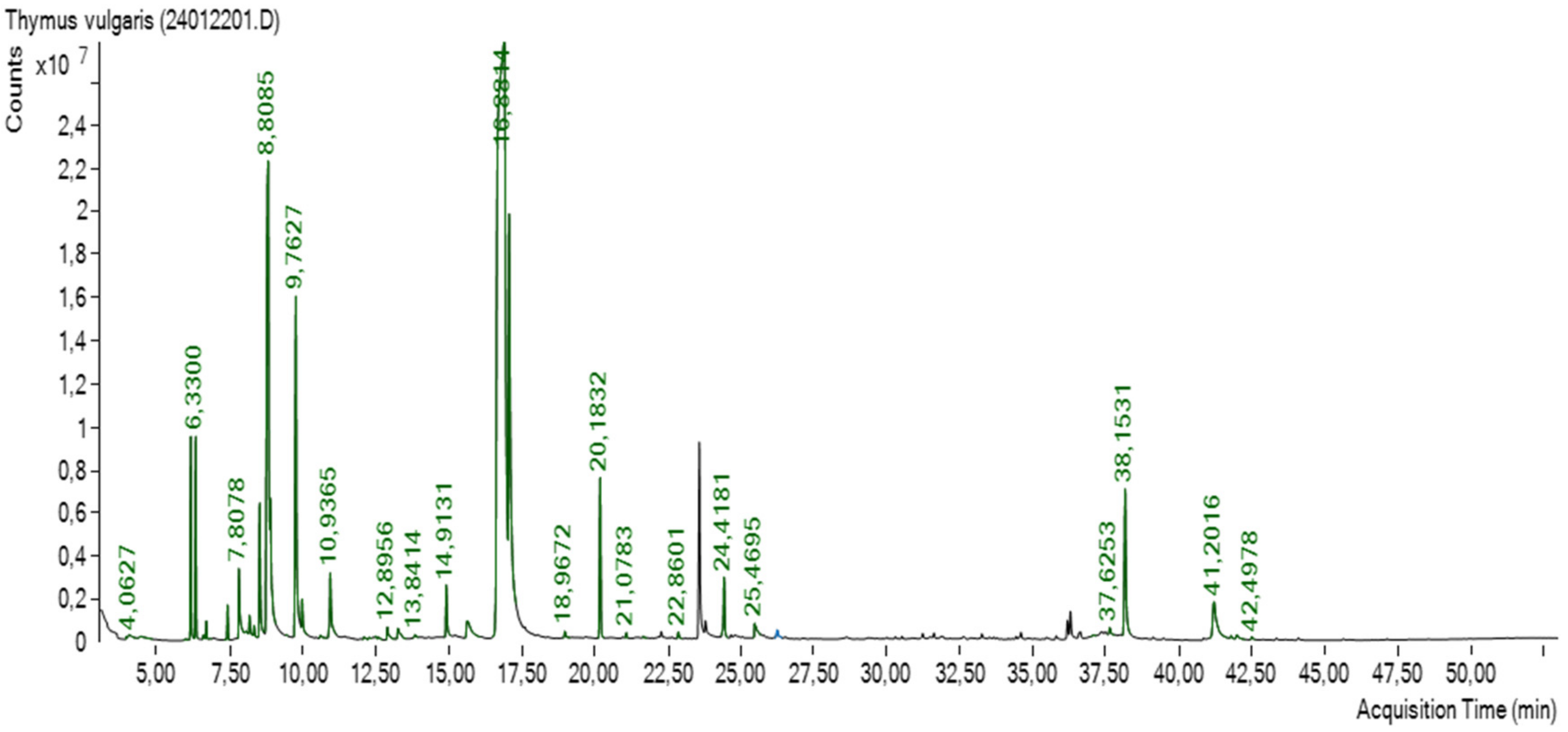
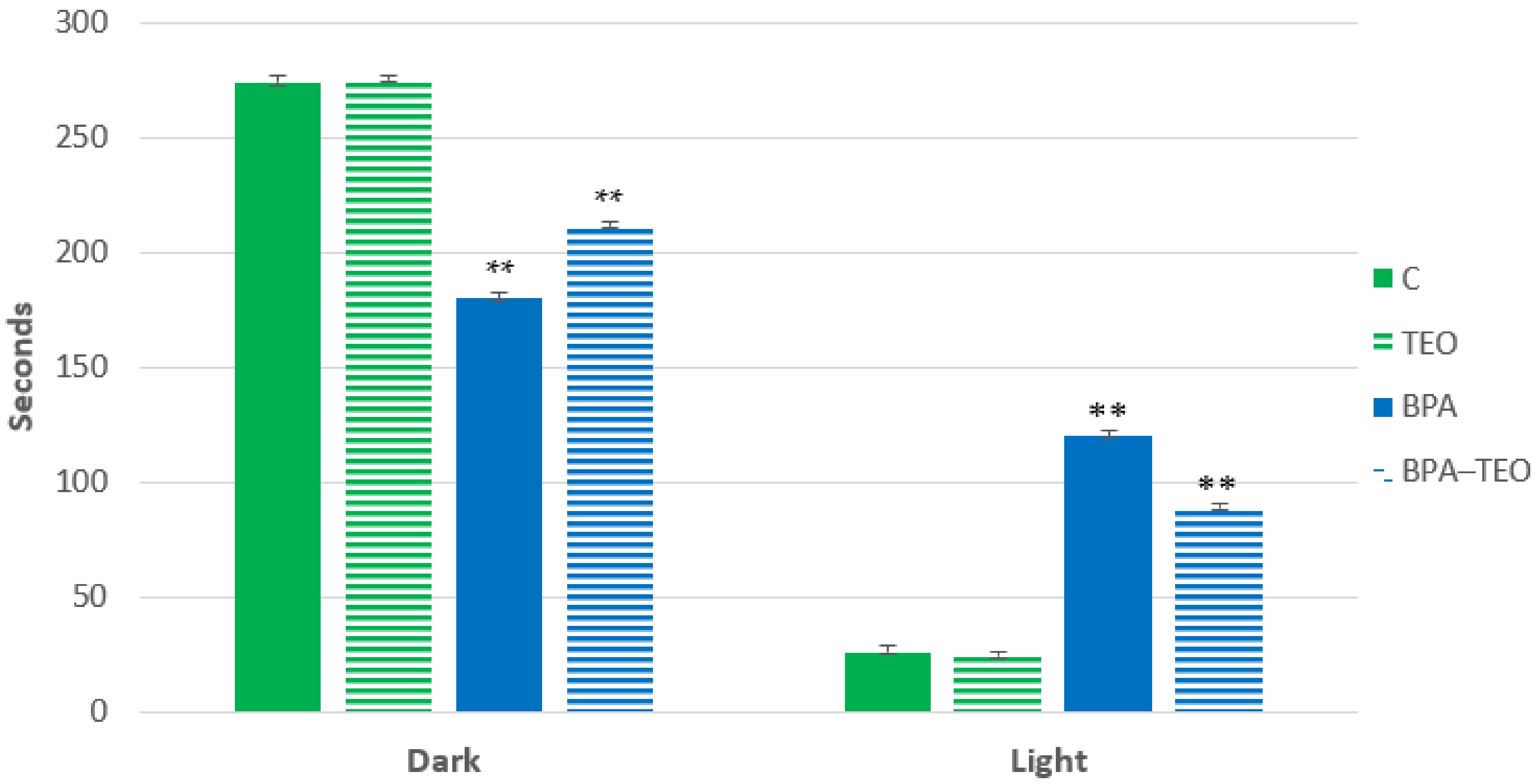
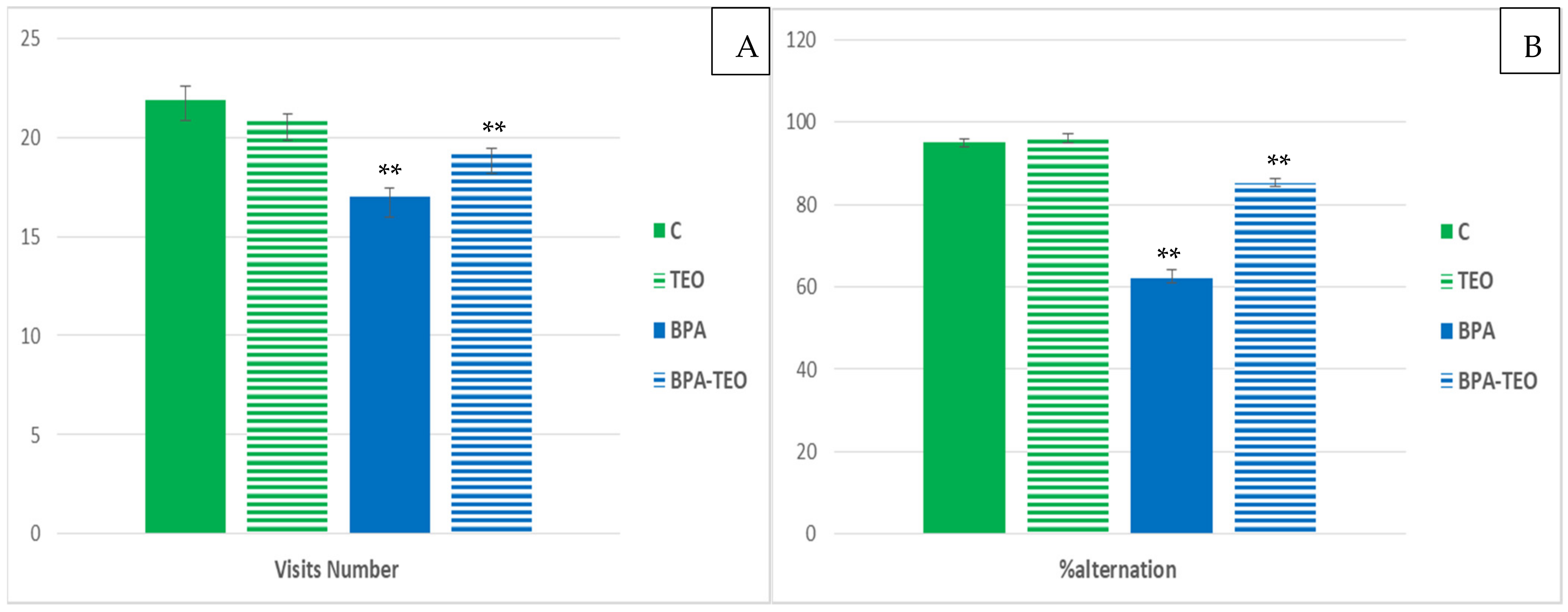

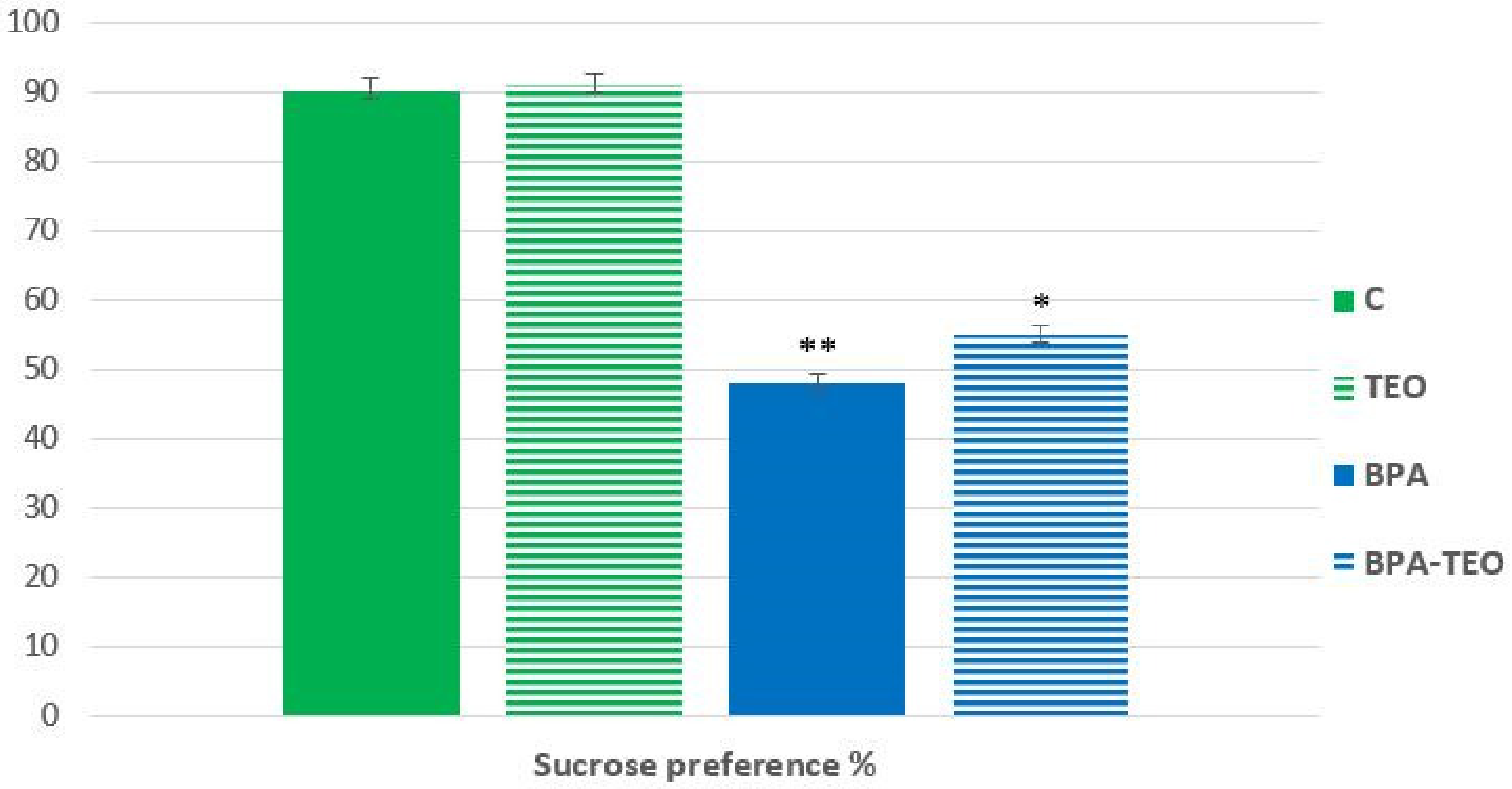

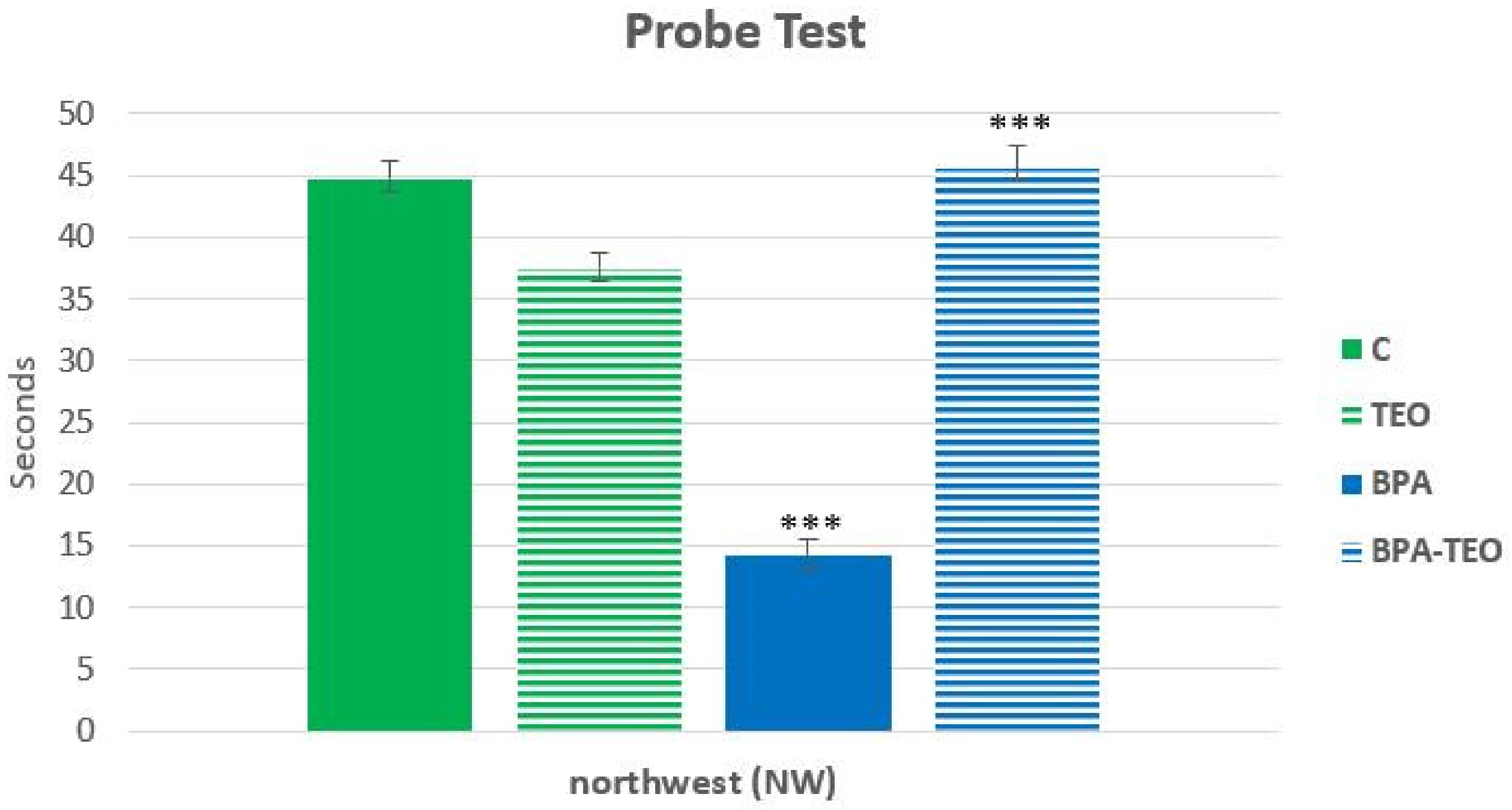
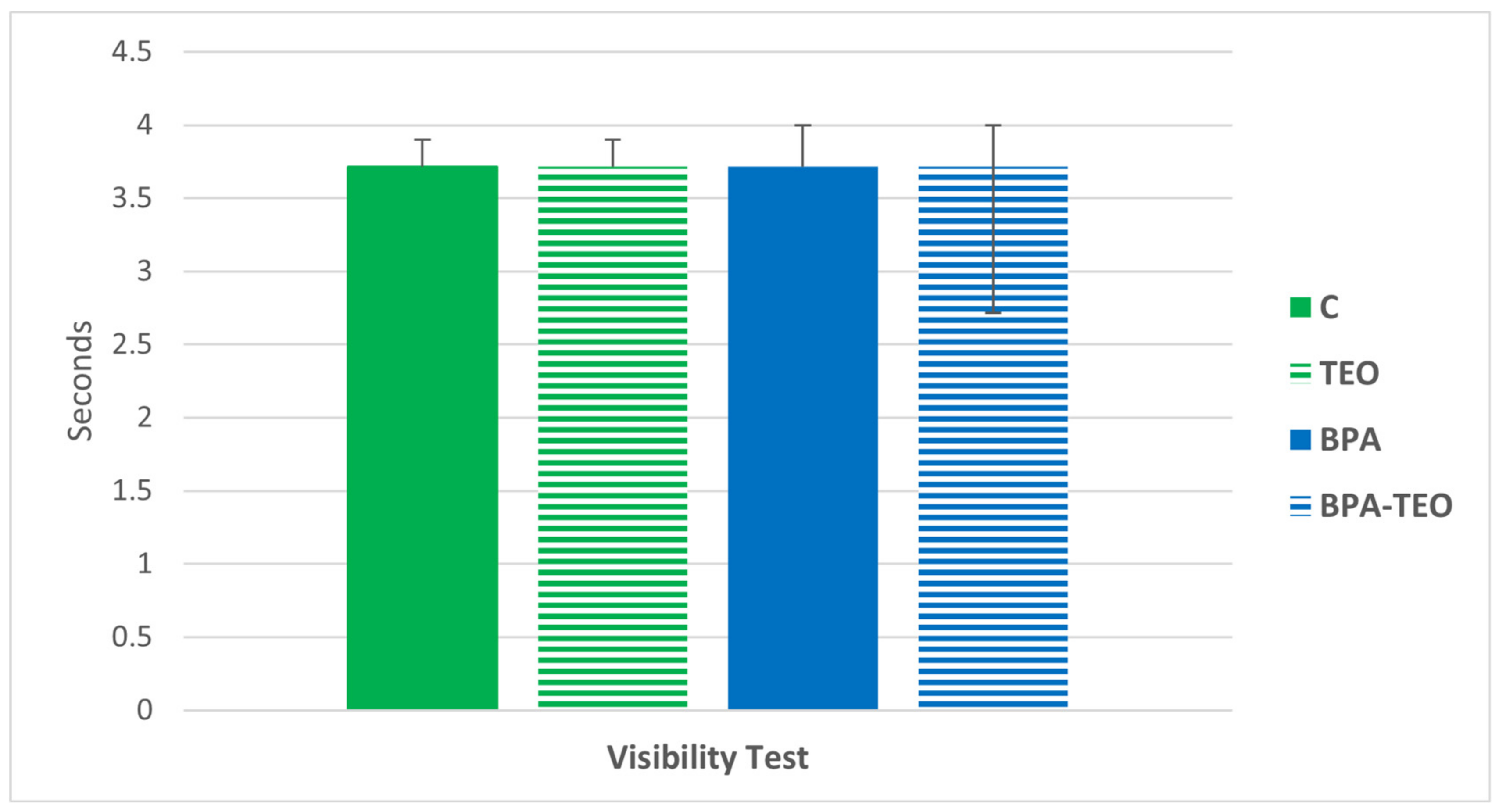

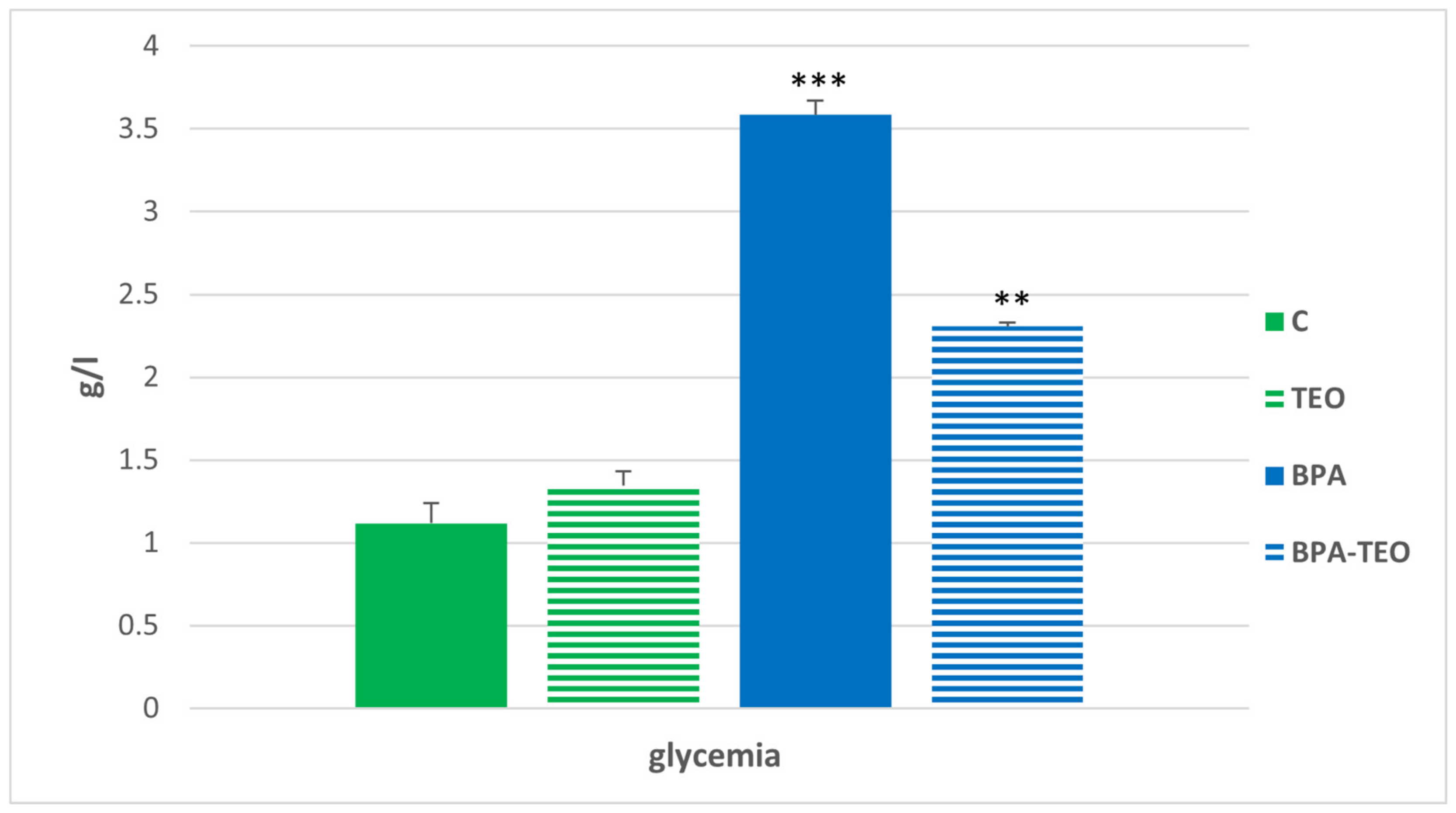
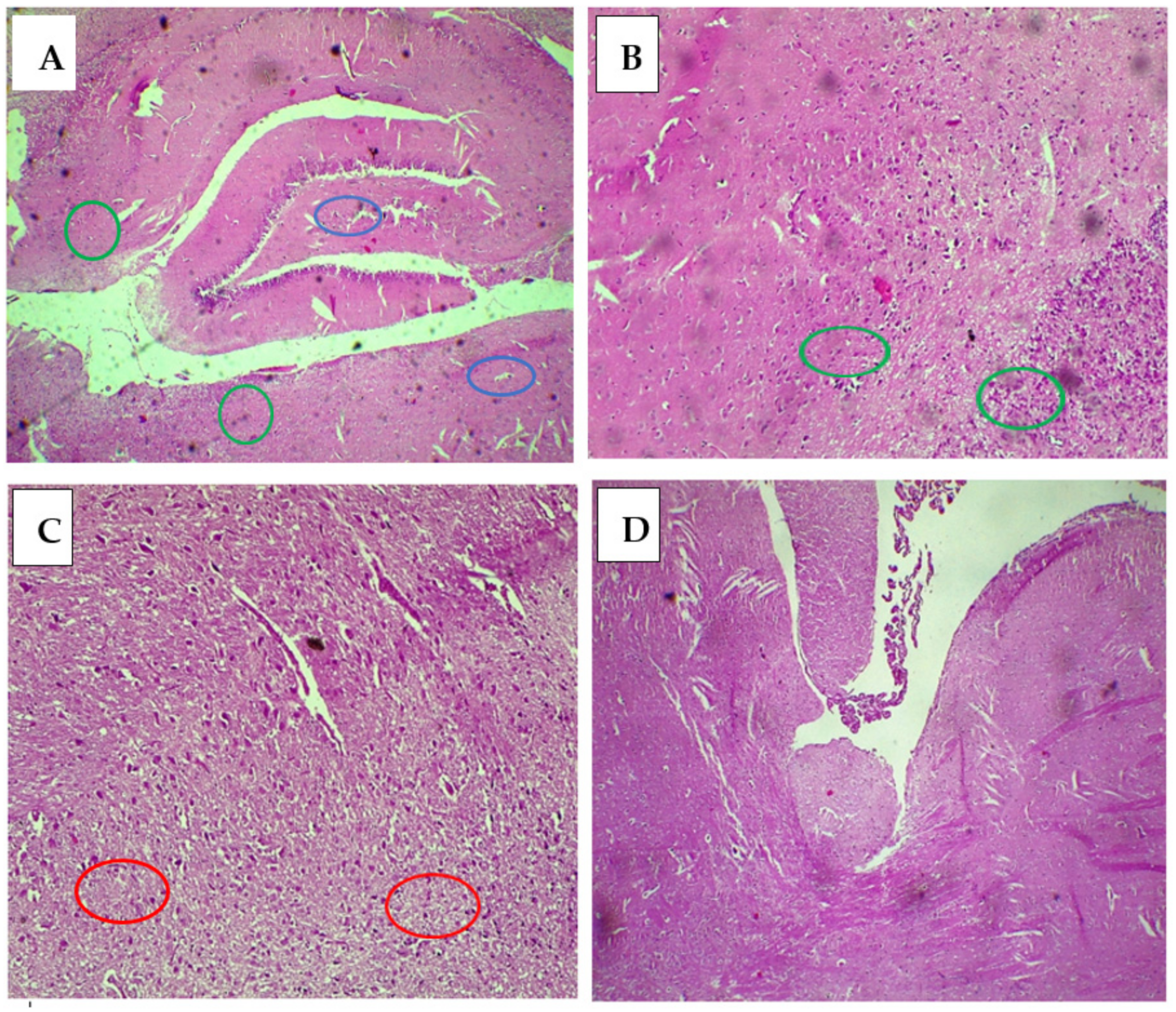
| Identified Compounds | RT | RIb | RIa | TEO% |
|---|---|---|---|---|
| endo-Borneol | 12.8956 | 1165 | 1165 | 0.4 |
| σ-Cadinene | 22.8601 | 1464 | 1502 | 0.2 |
| Caryophyllene | 20.1832 | 1412 | 1415 | 2.5 |
| Caryophyllene oxide | 24.4181 | 1494 | 1578 | 1.09 |
| Copaene | 18.9672 | 1377 | 1377 | 0.13 |
| p-Cymene | 8.8085 | 1024 | 1024 | 13.4 |
| Diphenylamine | 25.4695 | 1532 | 1622 | 0.59 |
| Humulene | 21.0783 | 1429 | 1442 | 0.09 |
| Linalool | 10.9365 | 1098 | 1099 | 0.07 |
| Lupanine | 38.1531 | 2142 | 2159 | 3.4 |
| Multiflorine | 41.2016 | 2317 | 2320 | 2 |
| α-Pinene | 6.33 | 930 | 931 | 2.26 |
| β-Pinene | 7.8078 | 988 | 981 | 1.4 |
| L-α-Terpineol | 13.8414 | 1197 | 1192 | 0.1 |
| σ-Terpinene | 9.7627 | 1057 | 1056 | 6.69 |
| Thymol | 16.8814 | 1302 | 1302 | 63.33 |
| Thymyl methyl ether | 14.9131 | 1234 | 1235 | 0.9 |
| Total identified (%) | 98.55 |
| Proteins | 8DPH | 8EEJ | 4EY5 | 6I0C | ||||||||
|---|---|---|---|---|---|---|---|---|---|---|---|---|
| Ligands | BE | BN | AAs | BE | BN | AAs | BE | BN | AAs | BE | BN | AAs |
| Co-Crystallized Ligand(s) | ||||||||||||
| T4U | −6.1 | 5 * | Asn331, Asp134, Cys207, Ile131, Leu209, Leu350, Phe327, Tyr358, Val208, Val354 | |||||||||
| LDP | −4.8 | 4 | Arg37, Arg220, Ile38, Thr44, Trp43, Tyr223 | |||||||||
| FAD | −7.4 | 5 | Arg37, Asp36, Asp224, His375, Ile38, Lys35, Thr44, Trp43, Tyr223 | |||||||||
| NAG | −5.0 | 2 | Arg296, Glu292, Gln291, Leu289, Leu76, Trp286, Ser293, Try72, Val294, Tyr341 | −5.1 | 3 | Asn289, Asn68, Ala277, Asp70, Gly283, Gln119, Thr284, Ile69, Pro285, Val280, Ser287, Thr120 | ||||||
| HUP | −4.5 | 2 | Arg296, Gly342, Glu292, Ser293, Leu289, Try341, Phe295, Trp286, Val294, Tyr72 | |||||||||
| MES | −4.6 | 3 * | Asn289, Glu276, Ala277, Gln119, Thr284, Ser287, Gly283, Val280, Asn68 | |||||||||
| GZ5 | −3.0 | 5 | Ala277, Asp70, Asn68, Asn289, Asn83, Ile69, Gln119, Gly283, Pro285, Thr284, Ser72, Ser79, Ser287, Pro84, Thr120, Trp82, Val280, Tyr332 | |||||||||
| Compounds | ||||||||||||
| α-Terpinene | −5.3 | 3 | Asn331, Cys207, Ile131, Leu209, Phe327, Trp130, Val208, Val215 | −4.4 | 4 | Arg37, Ala34, Lys35, Trp43, Trp382 | −5.6 | 3 | Leu289, Tyr341, Ser293, Tyr72, Trp286 | −4.4 | 2 | Ala277, Asn68, Asn289, Gln119, Glu276, Thr120 |
| p-Cymene | −5.1 | 4 | Asn331, Cys207, Ile131, Leu209, Trp130, Val208, Val215 | −4.3 | 3 | Arg37, Lys35, Trp43, Trp382 | −5.8 | 3 | Leu289, Tyr341, Ser293, Tyr72, Trp286 | −4.2 | 1 | Ala277, Asn68, Asn289, Asp70, Gln119, Glu276, Thr120 |
| Thymol | −5.4 | 5 | Asp134, Cys207, Ile131, Leu209, Ser110, Trp130, Tyr358, Val209, Val354 | −4.6 | 4 | Arg37, Ile38, Trp43, Tyr223 | −5.8 | 4 | Arg296, Tyr341, Glu292, Ser293, Val294, Trp286, Leu289, Tyr72 | −4.6 | 3 * | Ala277, Gln119, Asn289, Asp70, Thr120, Ile69, Glu276 |
| Neurotoxic substance | ||||||||||||
| Bisphenol A | −7.1 | 3 | Asn331, Asn351, Asp134, Cys207, Ile131, Leu209, Leu350, Phe327, Ser110, Trp130, Trp355, Try358, Val215, Val331, Val354 | −5.3 | 5 | Arg37, His375, Lys35, Trp43, Trp377 | −7.6 | 3 | Arg296, Asp74, Leu76, Leu289, Phe295, Ser293, Thr75, Trp286, Tyr72, Tyr341, Val294 | −6.4 | 4 | Ala277, Asn68, Asn289, Asp70, Gln119, Glu276, Gly149, Pro285, Thr284 |
| Neurotransmitters (Controls) | ||||||||||||
| Dopamine | −4.8 | 5 * | Ala113, Asp134, Cys207, Ile131, Trp130, Tyr358, Val208, Val354 | −4.7 | 4 * | Arg220, Asp36, Asp224, Glu45, leu236, Thr44, Trp43 | −5.5 | 3 * | Arg296, Gln291, Glu292, Leu289, Phe295, Ser293, Trp286, Tyr72, Tyr341, Val294 | −4.7 | 5 | Ala277, Asn68, Asn289, Asp70, Gln71, Gln119, Glu276, Gly149, Ile69, Thr120 |
| Glutamic acid | −4.4 | 2 | Asp134, Ile131, Leu209, Ser110, Trp130, Tyr358, Val208, Val354 | −4.4 | 3 * | Asp224, Glu45, Ile38, Thr44, Tyr223 | −5.0 | 3 | Arg296, Leu289, Glu292, Tyr341, Gly342, Gln291, Phe297, Trp286, Phe295, Val294, Ser293, | −4.9 | 3 | Asn68, Glu276, Asn83, Gln71, Asp70, Gln119, Ile69, Gly149, Thr120 |
| n-Methyl-D-aspartic acid | −4.4 | 3 | Asn351, Asp134, Cys207, Ile131, Ser110, Trp130, Tyr358, Val208, Val354 | −4.5 | 2 * | Arg37, Arg220, Asp224, Glu45, leu38, Trp43, Tyr224 | −4.8 | 3 | Arg296, Val294, Gln291, Phe295, Leu289, Glu292, Ser293, Tyr341, Trp286 | −4.7 | 3 | Asn83, Ile69, Asp70, Asn68, Thr120, Gln67, Pro84, Gly116, Trp82, Gly121 |
| Norepinephrine | −5.1 | 4 | Ala113, Asp134, Ile131, Leu209, Ser110, Trp130, Tyr358, Val208, Val354 | −4.8 | 4 * | Arg37, Arg220, Asp224, Glu45, Ile38, Thr44, Trp43 | −6.0 | 3 | Arg296, Leu289, Ser293, Gly342, Phe295, Tyr341, Trp286, Val294, Tyr72 | −5.2 | 3 | Thr120, Asn68, Ile69, Gln119, Asn289, Gly149, Asp70, Gln71, Ala277, Glu276 |
| Serotonin | −5.6 | 3 | Asp134, Cys207, Ile131, Leu209, Ser110, Trp130, Tyr358, Val135, Val208, Val354 | −4.6 | 5 | Ala34, Arg37, Asn237, Lys35 | −6.2 | 3 * | Arg296, Ser293, Leu289, Val294, Tyr72, Phe295, Tyr341, Trp286 | −5.2 | 3 * | Asp70, Gly149, Ala277, Phe290, Asn68, Thr120, Gln119, Ile69, Glu276, Asn289 |
Disclaimer/Publisher’s Note: The statements, opinions and data contained in all publications are solely those of the individual author(s) and contributor(s) and not of MDPI and/or the editor(s). MDPI and/or the editor(s) disclaim responsibility for any injury to people or property resulting from any ideas, methods, instructions or products referred to in the content. |
© 2025 by the authors. Licensee MDPI, Basel, Switzerland. This article is an open access article distributed under the terms and conditions of the Creative Commons Attribution (CC BY) license (https://creativecommons.org/licenses/by/4.0/).
Share and Cite
Kourat, D.; Adli, D.E.H.; Brahmi, M.; Alkholifi, F.K.; Bin Dayel, F.F.; Arabi, W.; Fauconnier, M.-L.; Bouzouira, B.; Kahloula, K.; Slimani, M.; et al. Role of Thymus ciliatus (Thyme) to Ameliorate the Acute Neurotoxicity Induced by Bisphenol A: In Vivo Supported with Virtual Study. Pharmaceuticals 2025, 18, 509. https://doi.org/10.3390/ph18040509
Kourat D, Adli DEH, Brahmi M, Alkholifi FK, Bin Dayel FF, Arabi W, Fauconnier M-L, Bouzouira B, Kahloula K, Slimani M, et al. Role of Thymus ciliatus (Thyme) to Ameliorate the Acute Neurotoxicity Induced by Bisphenol A: In Vivo Supported with Virtual Study. Pharmaceuticals. 2025; 18(4):509. https://doi.org/10.3390/ph18040509
Chicago/Turabian StyleKourat, Dallal, Djallal Eddine H. Adli, Mostapha Brahmi, Faisal K. Alkholifi, Faten F. Bin Dayel, Wafaa Arabi, Marie-Laure Fauconnier, Bakhta Bouzouira, Khaled Kahloula, Miloud Slimani, and et al. 2025. "Role of Thymus ciliatus (Thyme) to Ameliorate the Acute Neurotoxicity Induced by Bisphenol A: In Vivo Supported with Virtual Study" Pharmaceuticals 18, no. 4: 509. https://doi.org/10.3390/ph18040509
APA StyleKourat, D., Adli, D. E. H., Brahmi, M., Alkholifi, F. K., Bin Dayel, F. F., Arabi, W., Fauconnier, M.-L., Bouzouira, B., Kahloula, K., Slimani, M., & Sweilam, S. H. (2025). Role of Thymus ciliatus (Thyme) to Ameliorate the Acute Neurotoxicity Induced by Bisphenol A: In Vivo Supported with Virtual Study. Pharmaceuticals, 18(4), 509. https://doi.org/10.3390/ph18040509











